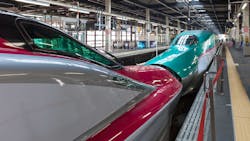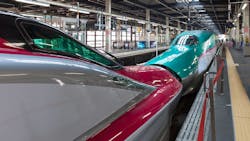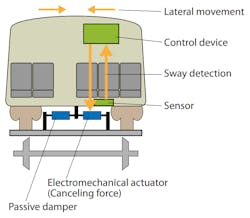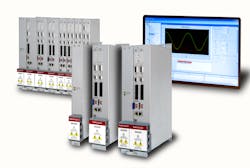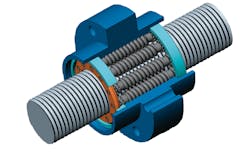Electromechanical Actuation on the Fast Track
President Biden’s proposed $2.3 trillion infrastructure plan includes funds for high-speed rail development. When high-speed rail finally takes off in the U.S., riders will benefit from the same engineering that now makes high-speed trains in Japan remarkably comfortable, even at speeds up to 225 mph.
One reason the latest generation of Japanese high-speed trains, known as “Shinkansen,” travel so smoothly is the adoption of electromechanical actuation and planetary roller screw technology for their active sway control systems.
Here’s how active sway control works: An accelerometer detects lateral sway of a train carriage due to the rails, air flow and other factors. A controller calculates the thrust to counter the sway and sends that signal to the actuator. Each wheel truck (i.e., the bogie or chassis with two axles, four wheels) has one actuator and a passive damper to attenuate lateral vibration.
Electromechanical sway actuators are part of the design of the E5 and E6 Series Shinkansen, or bullet train, operated by the East Japan Railway Company. The train cars boast a robust stabilizing system—which reduces sway by up to 50% when compared to conventional systems—serving as a counterforce to the vibration, inclination and high speed of the trains.
The system consists of an electromechanical actuator with roller screws, a servomotor and drive. Each of the train’s passenger cars include two stabilizing units, linked to a sensor that identifies forces acting on the cars.
Before adopting the electromechanical sway control system, the East Japan Railway Company powered its active sway control with a pneumatic system. Other Japanese bullet train rail companies use semi-active sway control relying on a variable oil damper to adjust damping force.
When the East Japan Railway Company decided to increase the maximum running speed of its E5 and E6 series trains to 225 mph, engineers knew they had to apply more force across a wider frequency band to reduce vibration for passengers. The Japanese railway industry is extremely stringent about performance and stress testing, so every component of the new sway system had to withstand a battery of tests for environmental concerns, endurance, side-loading and breakdowns.
After considering several proposals and sway-control designs, the East Japan Railway engineers selected an electromechanical actuation, or EMA, solution. The electromechanical design won also because of the size of the control system’s envelope, relative to the competitors’ offering; an EMA sway solution offers a stronger system in a more compact configuration, while providing fast response and high thrust.
When the conditions trigger an electromechanical actuator, the damper decreases the force to maximize its damping effect. When the actuator is not activated, a passive damper provides the damping force. The result: Passengers enjoy a safe, comfortable ride at speeds up to 225 mph.
Roller Screw Design Integral
Among the reasons these electromechanical solutions deliver greater performance is the use of superior materials and designs. For example, for the sway control system on the E5 and E6 trains, the engineering team incorporated a planetary roller screw with an electromechanical actuator and used trial-and-error to optimize the solution. To reach the desired level of endurance and safety, the engineers tested the planetary roller screw actuators under a variety of conditions that the Shinkansen would encounter.
The number of contact points between the rollers and the lead screw enable the roller screw to achieve higher load capacities than, say, a ball screw of the same diameter. However, each component maker relies on a unique manufacturing process to ensure accuracies in its roller bearings. A system designer can’t just assume a roller screw will perform better than a ball screw. The task is to ensure each roller screw’s tolerances meet the performance goals.
New Applications
Whether it’s a high-speed train or any other equipment, electromechanical solutions are an alternative to hydraulic and pneumatic actuation for high-endurance systems. For example, electromechanically actuated safety barriers now exist that can stop a 15,000-lb truck traveling at 50 mph, with less than 1 meter of penetration. These systems have held up under continual testing, more than one million cycles.
These all-electric actuation systems have an IP-68 Rating, meaning they can operate fully submerged in water and run on three-phase 208-volt, 380-volt or 480-volt power. And the barriers’ EMA will operate in a wide temperature band stretching from extreme desert conditions to arctic-like cold—conditions often incompatible with other actuation technologies.
Pneumatic and Hydraulic vs. Electric
It is often debated whether it is more costly to use electric versus pneumatic actuation. Consider, for instance, the cost in terms of labor and production downtime for changeover, involving rearranging a production line to manufacture a different product. For pneumatic systems the costs can reach hundreds of thousands of dollars, annually. Electric actuators, however, can retain settings, so annual changeover costs are greatly reduced.
In automotive testing, lab managers have traditionally turned to hydraulic actuation because it’s a known technology. But electromechanical automotive test systems are more prevalent because servomotors are competitively priced and the technology can now deliver comparable performances. Since electric motors are self-contained, there’s no need for filters or seals requiring cleaning or replacement.
Past electric systems would be controlled by an industrial PLC, but the latest electric servo motors have real-time controllers. Technologies like EtherCat allow the electric motor and actuator to communicate directly.
Designers who take a systems-oriented perspective on machine building will best see the pros and cons to electromechanical technology to achieve their customers’ desired goals. A crucial part is to work or with partners who are technology-neutral, yet still know all relevant technologies.
Enrico Bagnasco is the marketing content coordinator of the Electromechanical Motion Control Business Unit of Moog Inc. His duties have included European marketing development, brand development, organization of international trade events and global technical literature supervision. Contact him at [email protected].
About the Author
Enrico Bagnasco
Marketing Content Coordinator, Electromechanical Motion Control Division, Moog Inc.
Enrico Bagnasco is the marketing content coordinator of the Electro Mechanics and Motion Control Division of Moog Inc. His duties have included European Marketing development, brand development, organization of international trade events and global technical literature supervision.
